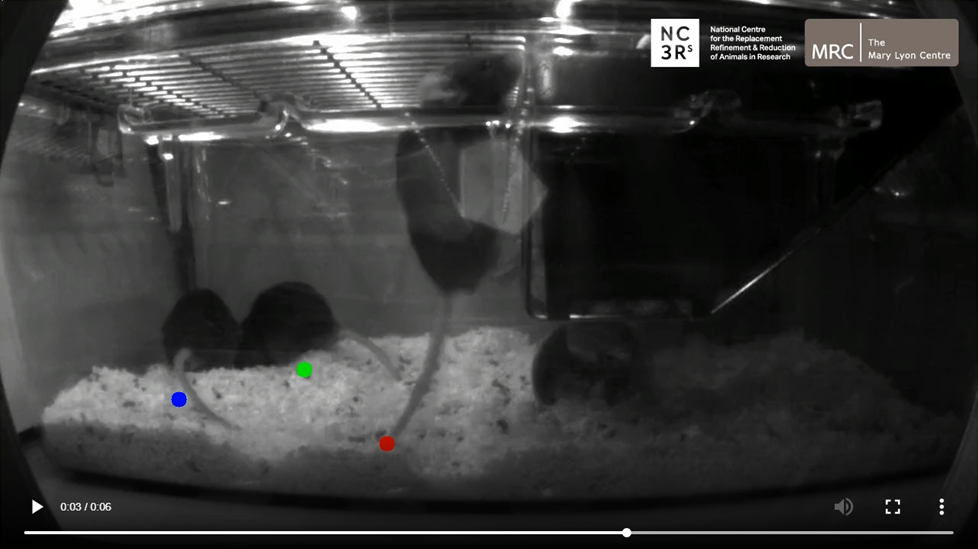Help us discover more about the secret lives of mice

We recently worked with MRC Harwell to create Secret Lives of Mice, a new citizen science project based on the Rodent Little Brother CRACK IT Challenge.
The project, hosted by Zooniverse, gives anyone the chance to get involved in improving laboratory mouse welfare by watching and labelling videos of mice in their home cages.
In this guest blog post, Emma Robinson, who is a volunteer on the project and is starting a degree in psychology this Autumn, shares her perspective on this exciting initiative.
Despite the fact that most of us look very different to mice (apart from when I put my hair up in buns), our biology is actually quite similar to theirs. So much so that 99% of our human genes have an equivalent gene in mice. This explains why I like cheese so much, and why mice are used in scientific and medical research. Because many mouse genes closely resemble those of us humans, scientists can make genetic changes in mice that to some extent replicate human conditions. By investigating the consequences of these changes, it is possible to find out more about the underlying processes taking place when a gene goes wrong. Many human diseases, such as diabetes and cancer, are caused by the interplay of hundreds of genes, so these experiments are important.

Emma Robinson
As well as these genetic similarities to humans, mice are small, easily housed and maintained, adapt well to new surroundings, reproduce quickly, and are relatively inexpensive, generally mild-tempered and docile (not at all like university students). This all contributes to their wide use in research. In fact, they are the most commonly used animal in research – in 2018, 2.57 million research procedures were carried out on mice in the UK, according to the Home Office.
In 2018 Ipsos MORI published a report presenting the results of its survey on public attitudes to the use of animals in research, including public acceptance and awareness. The findings of the report indicate that animal welfare is becoming a bigger consideration for many of us, and interest in finding out more about work to find alternatives and improve the welfare of animals in research is high and rising. While the general public widely accepts the use of animals in research for medical and scientific purposes (65% and 68% respectively), there is evidence of a shift towards greater questioning of animal research, including finding out more about alternative approaches that avoid the use of animals. The NC3Rs is one organisation working to find replacements for animals in research, as well as ways to reduce the use of animals and improve their welfare. Mouse welfare is a particularly high priority because they are so commonly used.
MRC Harwell is a research centre specialising in mouse genetics research. The NC3Rs, in collaboration with MRC Harwell, has launched a Citizen Science project, Secret Lives of Mice. This exciting collaborative project aims to use a novel system for studying the behaviour of mice in their home cage environment, 24/7. The Home Cage Analysis system was developed through CRACK IT, an exciting competition funding collaborations between industry, academics and SMEs to solve scientific challenges that will deliver 3Rs benefits, often resulting in a commercial product (like the show Dragons’ Den, except there is no Peter Jones or Deborah Meaden). More colloquially, the system is known as Rodent Little Brother (like the TV show Big Brother, except more interesting and with more drama). Using Rodent Little Brother, it is possible to study the secret lives of mice – and oh, how many secrets they hold…
Collecting data using Rodent Little Brother is important and highly beneficial (unlike the data we might have collected from Big Brother). It can help researchers learn more about the behaviour of the mighty mouse, particularly at night when they are most active – so in this way at least, they are like university students! Rodent Little Brother can be used to monitor, study, and observe the mice remotely using camera footage. Because the system is minimally invasive, the mice can go about their daily business without interruption from us pesky humans, reducing their stress levels. Researchers can observe the social interaction between mice in more detail than ever before, so they can assess the consequences of genetic alterations whilst also refining the way mice are studied to advance their welfare AND improving the quality of the information collected – the best of both worlds!
BUT (dun, dun, dun)... Rodent Little Brother generates a lot of data, and analysing all of it manually would be extremely time-consuming. So, this is where you come in! Yes, YOU!
Secret Lives of Mice needs more volunteers (like me!) to watch six-second video clips of mice in their home cages and label behaviours like eating, drinking and sleeping. This will teach computers to develop algorithms that recognise these behaviours automatically, which will help improve how mice are studied and cared for. This is an opportunity for anyone to contribute to improving laboratory mouse welfare, whether you’re a world renowned scientist, a former contestant on Love Island, a recent university graduate unsure of what to do next or someone who is simply interested in advancing scientific research.
Want to start discovering more about the secret lives of mice? Visit the Zooniverse website to get started!

A still frame from a Secret Lives of Mice video clip – what behaviours can you see here?
